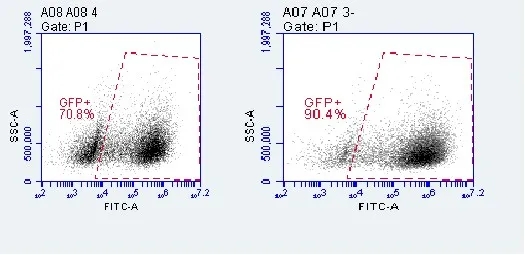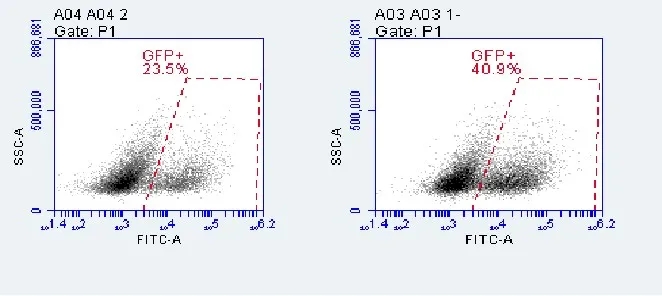Lentiviral Transduction Enhancer——LVTE
一、Product Introduction
Name
|
Lentiviral Transduction Enhancer, LVTE
|
Product Code
|
FH880807
|
Specifications
|
Concentration 100x; Volume 1ml
|
Shelf Life
|
6 months
|
Storage Conditions
|
4°C, avoid repeated freeze-thaw cycles
|
二、Product Overview
Suspension cells are a type of cell that grows independently of the surface of the supporting material and remains in a suspended state within the culture medium. Compared to adherent cells, suspension cells are more difficult to cultivate, prone to death, and challenging to transfect.
For these hard-to-infect cells, we typically prioritize using viral vectors, and lentivirus vectors have the advantages of infecting both dividing and non-dividing cells with long expression times. They have been widely used as ideal vectors for cellular therapy. However, lentivirus infection of suspension cells still presents challenges of low infection efficiency. Based on this, Weizhen Biotech has developed an infection enhancer that can make the infection of suspension cells more efficient.
The latest development by Weizhen's research team, Lentiviral Transduction Enhancer (hereinafter referred to as LVTE), is an infection enhancer that can increase membrane permeability and significantly improve the infection efficiency of lentivirus on suspension cells. For suspension cells that are difficult to infect, using this auxiliary infection reagent allows cells to achieve better virus infection effects for subsequent experiments.
三、Data Support
1、Transduction experiment of K562 cells
Cell Type
|
Chronic Myeloid Leukemia Cells K562
|
Virus
|
LV-EF1α-EGFP (8*10^8 IU/mL)
|
MOI
|
3
|
Experimental Steps: Infection of K562 cells with lentivirus, one group with the addition of Weizhen virus transduction enhancer LVTE and another without. After 72 hours, flow cytometry was used to identify GFP-positive cells.
Experimental Results: As shown in the figure below, the positive rate for K562 cells in the group without LVTE transduction enhancer was 70.8%, while in the group with LVTE added, the positive rate increased to 90.4%. Compared to the control group, the addition of lentiviral transduction enhancer LVTE resulted in a significant increase in cell positivity.
Flow cytometry analysis of GFP-positive cells (left panel: without LVTE addition, right panel: with LVTE addition)
2、T-cell Transduction Experiment
Cell Type
|
Frozen Human Primary T Cells
|
Virus
|
LV-EF1α-EGFP (8*10^8 IU/mL)
|
MOI
|
3
|
Experimental Steps: T cells were infected with lentivirus using the centrifugation infection method, one group with added lentiviral transduction enhancer LVTE and another without. After 72 hours, GFP-positive cells were identified by flow cytometry.
Experimental Results: As shown in the figure below, the positive rate for T cells without added LVTE transduction enhancer was 23.5%, while for the group with added LVTE, the positive rate increased to 40.9%. This indicates that after adding the lentiviral transduction enhancer LVTE, the GFP positivity rate also saw a significant increase.
Flow cytometry analysis of GFP-positive cells (left panel: without LVTE addition, right panel: with LVTE addition)
The efficiency of lentiviral vector-mediated transduction in suspension cells, such as T cells, is often low and requires the use of transduction enhancers. The newly developed Lentivirus Transduction Enhancer (LVTE) by Weizhen Biotech is sterile, low toxic, efficient, and environmentally friendly. It has the ability to enhance lentiviral transduction. When added to the culture medium, LVTE can enhance membrane transport both inside and outside the cells, promoting lentivirus entry into target cells, thereby significantly improving the infection efficiency of lentivirus for these difficult-to-infect cells. It is your ideal choice for infecting suspension cells.







